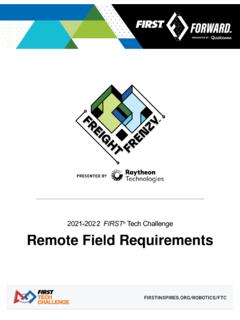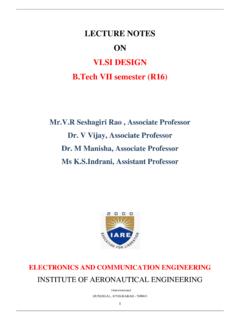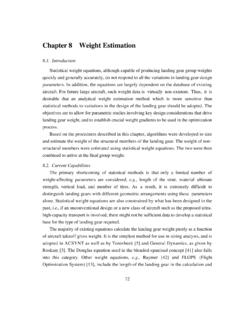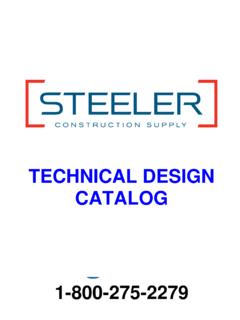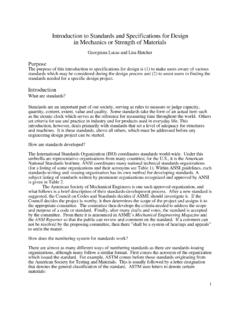Transcription of HVAC Engineering Fundamentals: Part 1 - HVAC TECH …
1 1 Chapter1 hvac Engineering Fundamentals: part IntroductionThis chapter is devoted to fundamental fundamentals certain prin-ciples which lay the foundation for what is to come. Starting with theoriginal author s suggested thought process for analyzing typical prob-lems, the reader is then exposed to a buzzword of our follows a discussion of codes and regulations, polit-ical criteria which constrain potential design solutions to the boundsof public health and welfare, and sometimes to special interest groupsponsored legislation. The final sections of the chapter offer a briefreview of the basic physics of heating, ventilating, and air conditioning( hvac ) design in discussions of fluid mechanics, thermodynamics,heat transfer, and psychrometrics. Numerous classroom and designoffice experiences remind us of the value of continuous awareness ofthe physics of hvac processes in the conduct of design Problem SolvingEvery hvac design involves, as a first step, a problem-solving pro-cess, usually with the objective of determining the most appropriatetype of hvac system for a specific application.
2 It is helpful to thinkof the problem-solving process as a series of logical steps, each ofwhich must be performed in order to obtain the best results. Althoughthere are various ways of defining the process, the following sequencehas been found the is the end result desired? For HVACthe objective usually is to provide an hvac system which will controlSource: hvac Systems design HandbookDownloaded from Digital Engineering Library @ McGraw-Hill ( )Copyright 2004 The McGraw-Hill Companies. All rights use is subject to the Terms of Use as given at the Chapter Onethe environment within required parameters, at a life-cycle cost com-patible with the need. Keep in mind that the cost will relate to theneeds of the process. More precise control of the environment almostalways means greater the problem, in this illustration, is to selectthe proper hvac systems and equipment to meet the objectives. Theproblem must be clearly and completely defined so that the proposedsolutions can be shown to solve the alternative is useful are always several different ways to solve any problem.
3 If re-modeling or renovation is involved, one alternative is to do the alternative must be evaluatedfor effectiveness and cost. Note that doing nothing always has a costequal to the opportunity, or energy, or efficiency lost by not doingsomething an factors enter into the selectionprocess effectiveness, cost, availability, practicality, and are intangible factors, too, such as an owner s desire for a par-ticular type of the selected alternative really solve the problem? the selected , construct, and op-erate the the problems been solved? The objectives met?What improvements might be made in the next design ?Many undertakings fail, or are weak in the end result, due to failingto satisfy one or more of these problem-solving increments. There isan art in being able to identify the key issue, or the critical successfactors, or the truly beneficial alternative. Sometimes the evaluationwill be clouded by constraint of time, budget, or prejudice.
4 Occasion-ally there is an error in assumption or calculation that goes un-checked. The best defense against disappointment is the presence ofgood training and good experience in the responsible Value EngineeringValue analysisorvalue Engineering (VE) describes a now highly so-phisticated analytical process which had its origins in the materielshortages of World War II. In an effort to maintain and increase pro-duction of war-related products, engineers at General Electric devel-oped an organized method of identifying the principal function or ser-vice to be rendered by a device or system. Then they looked at thecurrent solution to see whether it truly met the objective in the sim-plest and most cost-effective way, or whether there might be an alter-native approach that could do the job in a simpler, less costly, or moreHVAC Engineering fundamentals : part 1 Downloaded from Digital Engineering Library @ McGraw-Hill ( )Copyright 2004 The McGraw-Hill Companies.
5 All rights use is subject to the Terms of Use as given at the Engineering fundamentals : part 1 3durable way. The results of the value Engineering process now per-meate our lives, and the techniques are pervasive in business. Con-sider our improved automobile construction methods, home appli-ances, and the like as examples. Even newer technologies such asthose pertaining to television and computers have been improved byquantum leaps by individuals and organizations challenging thestatus quo as being inadequate or too Dell Isolo is generally credited as being the man whobrought value Engineering to the construction industry, which indus-try by definition includes hvac systems. Dell Isolo both wrote thebook 1and led the seminars which established the credibility of thepractice of value Engineering in architectural and Engineering firmsand client offices across the is a national professional society called SAVE (Society ofAmerican Value Engineers), headquartered in Smyrna, Georgia.
6 Thesociety certifies and supports those who have an interest in and com-mitment to the principles and practices of the VE Engineering in construction presumes an issue at hand. It canbe a broad concern such as a system, or it can be a narrow concernsuch as a device or component. TheVE processattacks the status quoin four and succinctly identify the pur-pose(s) of the item of concern. Then gather information related to per-formance, composition, life expectancy, use of resources, cost to con-struct, the factors which comprise its duty, etc. Make graphs, charts,and tables to present the information. Identify areas of high cost infabrication and in operation. Understand the item in general and ask the question, Do we even needthis thing, this service at all? Or are we into it by habit or tradition?If the function is needed, then ask, How else could we accomplish thesame objective? Could we reasonably reduce our expectation or ac-ceptably reduce the magnitude of our effort?
7 Could we eliminate ex-cess material (make it lighter or smaller)? Could we substitute a lessexpensive assembly? Could we eliminate an element of assembly la-bor? Could we standardize a line of multisize units into just a fewcomponents?In this phase, we learn not to criticize, not to evaluate, for the cra-zies spawn the winners. Don t be down on what you are not up on. Be creative and open-minded. Keep a written record of the the developed ideas for differentways of doing the same thing, now evaluate the objective and subjec-tive strengths and weaknesses of each alternative. Study performanceHVAC Engineering fundamentals : part 1 Downloaded from Digital Engineering Library @ McGraw-Hill ( )Copyright 2004 The McGraw-Hill Companies. All rights use is subject to the Terms of Use as given at the Chapter Oneversus cost cost both to construct and to operate. Look for the alter-native which will work as well or better for the least overall cost.
8 Thiswill often be a different solution from the that an analysis effort solely for the purpose of cutting cost isnot really value Engineering ; for the objective of minimized life cyclecost is often compromised. There are enough buildings in this countrywith fancy finishes and uncomfortable occupants to attest to this as-sertion. As John Ruskin said many years ago:It is unwise to pay too much but it is worse to pay too little. When youpay too much you lose a little money. When you pay too little you some-times lose everything, because the thing you bought was incapable ofdoing the thing it was bought to do. The common law of business balanceprohibits paying a little and getting a lot it can t be done. If you dealwith the lowest bidder it is well to add something for the risk you if you do that you will have enough to pay for something the best ties back into a weakness of manyengineers and designers: They have great ideas, but they have a hardtime getting these ideas implemented.
9 By first understanding the pur-pose of a device or system, then producing good data to understandcurrent performance, and finally developing an alternative with doc-umented feasibility, the sales effort is greatly forced-air furnaces are an example of an hvac unit which hasbeen improved over time by value Engineering . The purpose of thefurnace now, as before, is to use the chemical energy of a fuel to warmthe environment, , to heat the house. But there is a world of dif-ference between the furnace of the 1930s, with its cast-iron or heavy-metal refractory-lined firebox and 4-ft-diameter bonnet, and the high-technology furnaces of today. Size is down, capacity is up, weight isdown, relative cost is down, fuel combustion efficiency is up, and re-liability is debatably drives for pumps and fans are devices which havebeen improved to the point of common application. The operating-costadvantages of reduced speed to match the load have been knownand used in industry for a long time, but technology has taken its timeto develop reliable, low-cost, variable-speed controllers for commercialmotors, such as variable-frequency drives now used in hvac value Engineering seems to share some common analytical tech -nique with Sec.
10 On problem solving, the dual presentation is in-tentional. Both discussions are approaches to solving problems, to im-proving service. The first is an interpretation of a mentor s example, hvac Engineering fundamentals : part 1 Downloaded from Digital Engineering Library @ McGraw-Hill ( )Copyright 2004 The McGraw-Hill Companies. All rights use is subject to the Terms of Use as given at the Engineering fundamentals : part 1 5the second is a publicly documented, formal procedure. The hvac system designer will benefit greatly if she or he can commit to ananalytical thought process which defines the problem, proposes solu-tions, identifies the optimum approach, and finally presents the so-lution in a credible and compelling Codes and RegulationsNo hvac designer should undertake a design task without first hav-ing an awareness of and hopefully a working familiarity with the var-ious codes and ordinances which govern and regulate building con-struction, product design and fabrication, qualification of engineers inpractice, etc.




